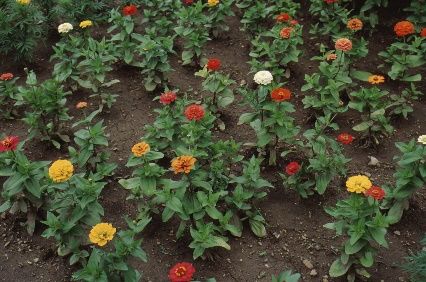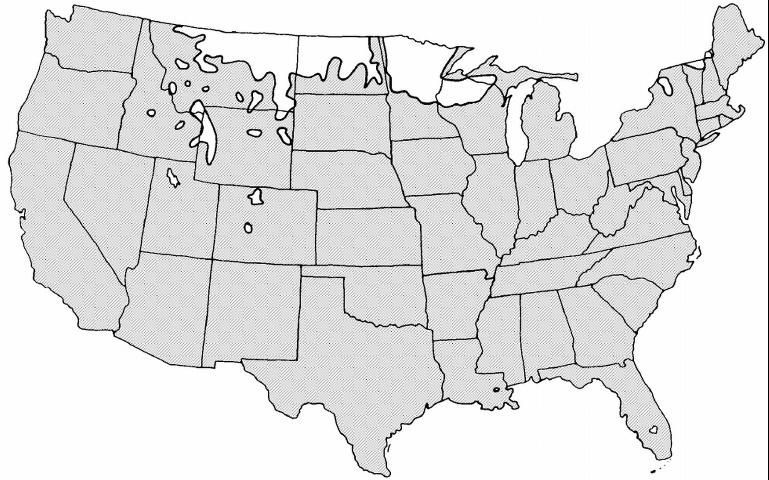Introduction
There are many varieties of zinnia with widely varying heights and flower colors. They may be as short as 6 inches or as tall as 3 feet. The plants are spaced 8 to 12 inches apart and flowers can be any color except for blue. They are tolerant of all but wet soils and need exposure to full sun. Plants producing flowers with high centers surrounded by only one or two rows of petals should be discarded. Tall varieties may be pinched when young to encourage branching. Old flowers are removed to encourage continued flowering.

Credit: Edward F. Gilman, UF/IFAS
General Information
Scientific name: Zinnia spp.
Pronunciation: ZIN-nee-uh species
Common name(s): zinnia
Family: Compositae
Plant type: annual
USDA hardiness zones: all zones (Figure 2)
Planting month for zone 7: Mar; Apr; Sep
Planting month for zone 8: May; Jun
Planting month for zone 9: Apr; Sep; Oct
Planting month for zone 10 and 11: Mar; Sep; Oct
Origin: native to North America
Invasive potential: not known to be invasive
Uses: mass planting; container or above-ground planter; cut flowers; edging
Availability: generally available in many areas within its hardiness range

Credit:
Description
Height: 1 to 3 feet
Spread: 1 to 2 feet
Plant habit: upright
Plant density: open
Growth rate: fast
Texture: medium
Foliage
Leaf arrangement: opposite/subopposite
Leaf type: simple
Leaf margin: entire
Leaf shape: ovate
Leaf venation: parallel
Leaf type and persistence: not applicable
Leaf blade length: 2 to 4 inches
Leaf color: green
Fall color: not applicable
Fall characteristic: not applicable
Flower
Flower color: yellow; white; pink; salmon; purple; lavender; orange
Flower characteristic: showy
Fruit
Fruit shape: no fruit
Fruit length: no fruit
Fruit cover: no fruit
Fruit color: not applicable
Fruit characteristic: inconspicuous and not showy
Trunk and Branches
Trunk/bark/branches: not applicable
Current year stem/twig color: green
Current year stem/twig thickness: medium
Culture
Light requirement: plant grows in full sun
Soil tolerances: clay; sand; acidic; loam
Drought tolerance: high
Soil salt tolerances: unknown
Plant spacing: 12 to 18 inches
Other
Roots: not applicable
Winter interest: not applicable
Outstanding plant: not particularly outstanding
Pest resistance: very sensitive to one or more pests or diseases which can affect plant health or aesthetics
Use and Management
The seeds are usually planted directly into the garden. If planted indoors, the seedlings become spindly, especially if started too early. The seed germinates in one to two weeks at temperatures between 70°F and 80°F. In addition to spring, zinnia can be planted from August to September in southern Florida. Dwarf zinnias less than 10 inches tall include the 'Dasher', Dreamland', 'Lollipop', 'Peter Pan' and 'Small World' series, 'Fantastic', 'Short Stuff', and 'Thumbelina'. Intermediate-sized selections grow no more than about 15 inches tall and include the 'Pulcino' series, and the cultivars 'Pumila', 'Rose Pinwheel', and 'Starlight'. The tallest zinnias are in the 'Ruffles' and 'Splendor' series, and the cultivar 'State Fair'.
Pests and Diseases
Aphids suck plant juices and coat the leaves with sticky honeydew.
Four-lined plant bug causes small, round, brown sunken spots on the leaves.
Mites cause the foliage to lose its green color and become bronzed or stippled.
Blight starts as reddish-brown spots with graying centers. Dark brown cankers form on the stems and flowers are spotted or completely blighted. The disease is also called alternaria leaf spot.
Powdery mildew is found on zinnia, particularly late in the season. The disease causes a white to grayish powdery growth on the leaves.
Bacterial leaf spot causes reddish-brown, angular spots on the leaves and can cause plants to die out by mid-August.